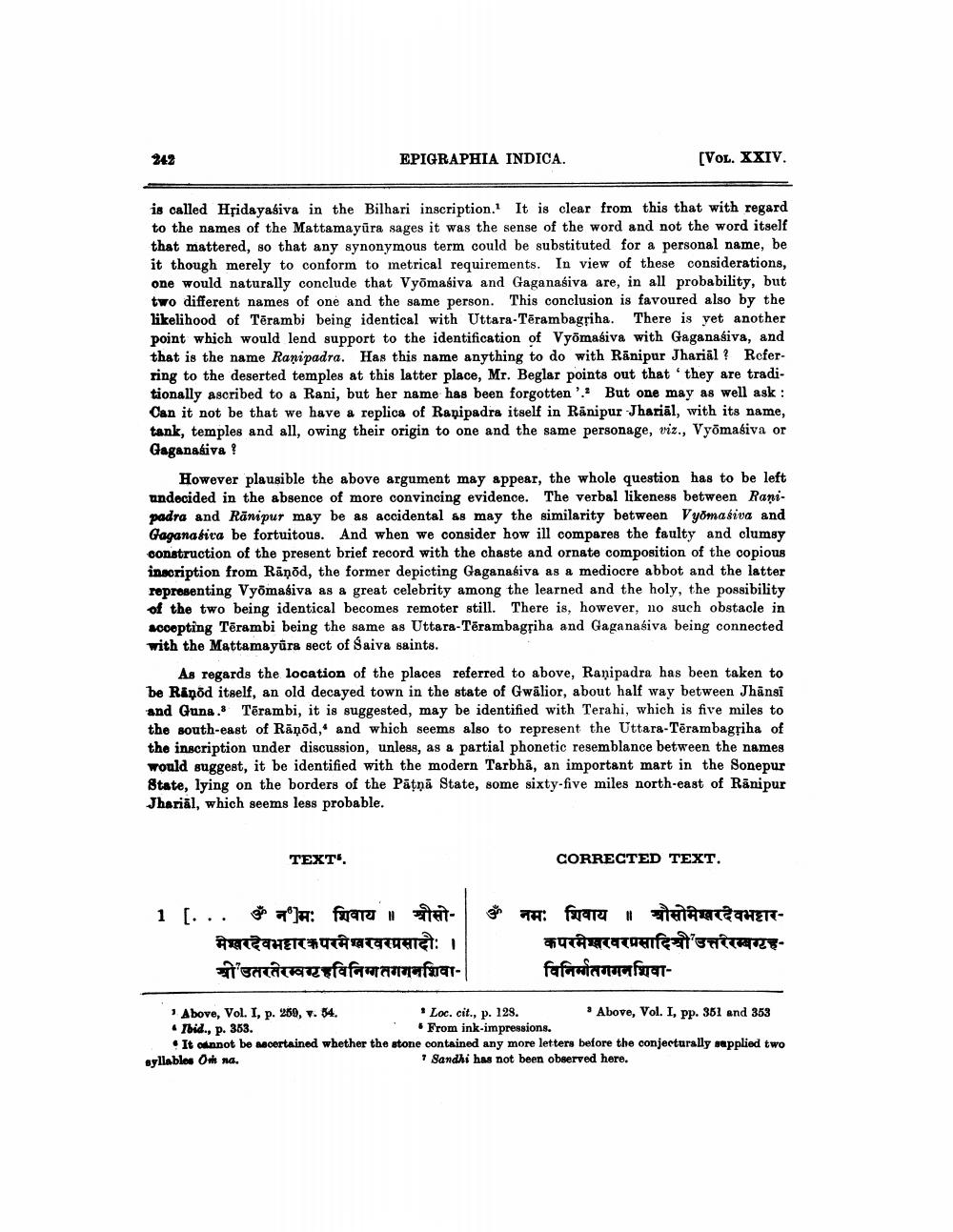________________
EPIGRAPHIA INDICA.
(VOL. XXIV.
is called Hridayasiva in the Bilhari inscription. It is clear from this that with regard to the names of the Mattamayūra sages it was the sense of the word and not the word itself that mattered, so that any synonymous term could be substituted for a personal name, be it though merely to conform to metrical requirements. In view of these considerations, one would naturally conclude that Vyömasiva and Gaganaśiva are, in all probability, but two different names of one and the same person. This conclusion is favoured also by the likelihood of Tērambi being identical with Uttara-Tērambagriha. There is yet another point which would lend support to the identification of Vyömasiva with Gaganasiva, and that is the name Ranipadra. Has this name anything to do with Rānipur Jharial ? Referring to the deserted temples at this latter place, Mr. Beglar points out that they are traditionally ascribed to a Rani, but her name has been forgotten'. But one may as well ask : Can it not be that we have a replica of Ranipadra itself in Ränipur Jhariāl, with its name, tank, temples and all, owing their origin to one and the same personage, viz., Vyömasiva or Gaganasiva?
However plausible the above argument may appear, the whole question has to be left undecided in the absence of more convincing evidence. The verbal likeness between Ranipadra and Rānipur may be as accidental as may the similarity between Vyömasiva and Gaganasita be fortuitous. And when we consider how ill compares the faulty and clumsy construction of the present brief record with the chaste and ornate composition of the copious inscription from Rāņod, the former depicting Gaganabiva as a mediocre abbot and the latter representing Vyömasiva as a great celebrity among the learned and the holy, the possibility of the two being identical becomes remoter still. There is, however, no such obstacle in accepting Tērambi being the same as Uttara-Tērambagriha and Gaganaśiva being connected with the Mattamayūra sect of Saiva saints.
As regards the location of the places referred to above, Ranipadra has been taken to be Riņod itself, an old decayed town in the state of Gwālior, about half way between Jhānsi and Guna. Tērambi, it is suggested, may be identified with Terahi, which is five miles to the south-east of Rāņöd,and which seems also to represent the Uttara-Tērambagriha of the inscription under discussion, unless, as a partial phonetic resemblance between the names would suggest, it be identified with the modern Tarbhā, an important mart in the Sonepur State, lying on the borders of the Pātņā State, some sixty-five miles north-east of Ränipur Jhariāl, which seems less probable.
TEXT.
CORRECTED TEXT.
sä
1 [. . . s FJA: fwatu a t-
मेश्वरदेवभट्टारकपरमेश्वरवरप्रसादीः । Teata morfafawanafaal
T: facere I KATECHET
कपरमेश्वरवरप्रसादियों उत्तरेरम्बग्रहविनिर्मातगगनशिवा
Above, Vol. I, p. 269, v. 54.
Loc. cit., p. 128.
Above, Vol. I, pp. 361 and 353 • Tbid., p. 363.
From ink-impressions. . It onnot be ascertained whether the stone contained any more letters before the conjecturally supplied two syllables Oth na.
+ Sandhi has not been observed here.




